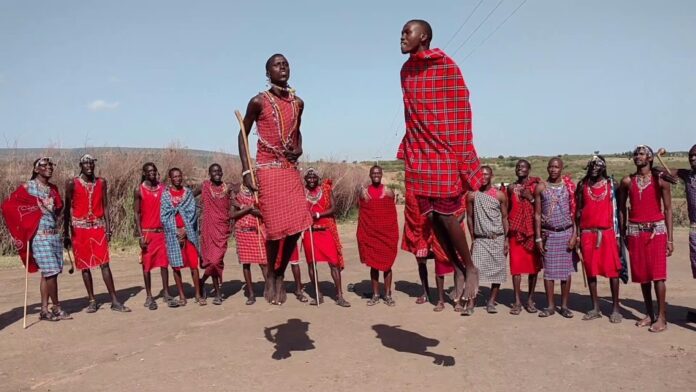In the heart of East Africa, a captivating ritual known as Adumu — or the “Maasai Jumping Dance” — has become a hallmark of Maasai culture. This ancient dance is more than just an eye-catching spectacle; it is a celebration of strength, tradition, and community spirit.
Travelers who visit Kenya and Tanzania often find themselves entranced by the sight of Maasai warriors leaping gracefully into the air, their brightly colored shukas (traditional cloth wraps) swaying with each jump. But behind the spectacle lies a rich cultural narrative worth exploring.
Origins of Adumu
The Maasai people, semi-nomadic pastoralists who have roamed the plains of Kenya and Tanzania for centuries, have a deep-rooted connection to their land, livestock, and traditions.
Adumu is part of the Eunoto ceremony, a rite of passage for young Maasai men transitioning from warriors (morans) to elders. The dance is a key component of this celebration, showcasing the strength and vitality of the young warriors.
In Maasai culture, jumping is seen as a way to prove one’s physical prowess and stamina. The higher a warrior can jump, the more respect he earns among his peers and community. Adumu is not just about height; it’s also about rhythm, balance, and grace, all of which are important qualities for a Maasai warrior.
Although traditionally performed by men, women often play a significant role in the ceremonies surrounding the dance. They sing, chant, and cheer on the participants, adding to the communal energy of the event.

Adumu reinforces the Maasai’s connection to their land and livestock. As herders, the Maasai rely heavily on their cattle, and their physical strength is essential for safeguarding their herds from wild animals and navigating the challenging terrain of the East African savannah. In many ways, Adumu is a metaphor for the endurance needed to survive and thrive in such an environment.
The Dance in Modern Times
While Adumu remains a key cultural ritual among the Maasai, it has also gained international attention as a symbol of East African identity. Tourists visiting Maasai communities are often invited to watch or participate in the dance, and the image of Maasai warriors leaping into the air has become iconic in global media.
However, it’s important to remember that Adumu is not just a performance for outsiders; it holds deep spiritual and cultural significance for the Maasai people.
The Global Influence of Adumu
The visual power of Adumu has caught the eye of people around the world, appearing in documentaries, fashion shows, and even modern dance performances. As Maasai warriors leap into the air with stunning athleticism, the dance conveys a universal message of human strength and unity.
What makes Adumu so enduringly popular is its simplicity and universality. At its core, it’s about the human ability to rise—both physically and metaphorically. Whether on the plains of East Africa or in the imaginations of people worldwide, Adumu remains a symbol of perseverance, vitality, and cultural pride.


Wow, awesome blog layout! How long have you been blogging for?
you made blogging look easy. The overall look of
your site is excellent, let alone the content!
Very nice post. I just stumbled upon your blog and wanted to
say that I have really enjoyed surfing around your blog posts.
In any case I’ll be subscribing to your rss feed and I hope you
write again very soon!